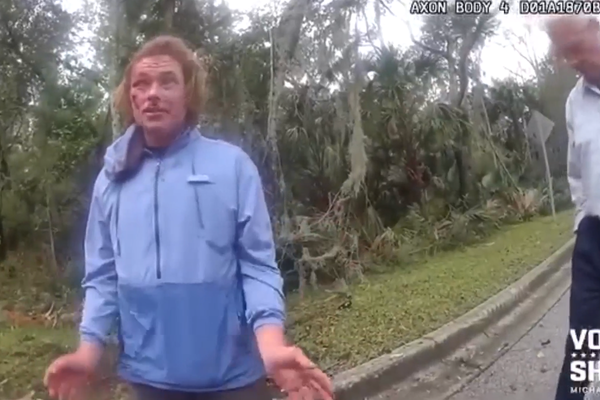
Good morning.
Today’s newsletter comes to you from Manchester, original home of the Guardian (est 1821), and me, Helen Pidd, your friendly north of England editor. I’ll be writing the daily briefing alongside Nimo for the next few weeks.
Our latest edition concerns events in Japan 12 years ago, when a huge earthquake struck off the country’s north-east coast, triggering a tsunami that caused the worst nuclear disaster since Chornobyl.
More than a decade later, the clean-up continues at Fukushima. This week the Japanese government announced that work will begin on Thursday to pump more than one million tonnes of water into the sea from the destroyed Daiichi nuclear power plant, in a move that has prompted horror from environmental groups and consternation in neighbouring countries.
Is it madness to pollute the Pacific Ocean with enough tainted water to fill at least 500 Olympic-sized swimming pools?
I spoke to the Guardian’s Japan correspondent, Justin McCurry, as he packed his bags to return to Fukushima, saying that he had no qualms about drinking the local sake and how the area has become a surfing hotspot once more.
In depth: ‘Plants pump diluted tritium into the sea all the time and nobody bats an eyelid’

On 11 March 2011 a magnitude 9.0 earthquake triggered a tsunami that knocked out the backup electricity supply at the Fukushima Daiichi nuclear power plant on Japan’s north-eastern Pacific coast, leading to meltdowns in three of its reactors.
Ever since, 1.34m tonnes of radioactive water has accumulated at the site, according to the plant operator, Tokyo Electric Power Company (Tepco). This includes liquid used for cooling, plus rain and groundwater that has seeped in.
Earlier this year, Justin visited the site, and saw the thousand or so steel tanks being used to house the contaminated water (pictured above). “They’re three storeys high and are all together across a wide area,” he said.
Tepco says it will soon run out of storage room and this week was granted permission to start releasing “treated” water from the tanks into the Pacific Ocean.
The plan has caused controversy because the water contains tritium, a radioactive form of hydrogen that can’t be removed by the facility’s water filtration technology.
It will not be pumped out all at once, but over the next 30 to 40 years. The first discharge, starting on Thursday (weather permitting) will total 7,800 cubic metres over about 17 days, Tepco said. For those of you not great at visualising volumes, that’s about three Olympic swimming pools.
***
Is it dangerous?
The International Atomic Energy Agency (IAEA) has approved the discharge, saying that the radiological impact on people and the environment would be “negligible”.
The levels of tritium will be 1/40th of the legal level for discharges, Tepco insists, and has promised to upload hourly data on water quality. The scientific consensus has persuaded Justin that “as long as you are exposed to tritium in low doses, it doesn’t represent a threat to human health”.
Greenpeace, however, has described the filtration process as flawed, and warned that an “immense” quantity of radioactive material will be dispersed into the sea over the coming decades. Concerns have also been raised by the Pacific Islands Forum (PIF), the main intergovernmental organisation representing the region, which has been consulting with Japan over the release for the past two years and in January said it had “grave concerns” over the plans. In June, the PIF issued a statement drawing attention to international laws against dumping nuclear waste in the Pacific.
Justin has come to the view that storing the water indefinitely is not a realistic option: “When does it end? What are you going to do with 2m tonnes, 3m tonnes? What about a leak? That area gets tsunamis, it gets quakes, it gets typhoons. What if something like that were to happen and lots of the tanks were damaged?”
But much remains unknown. Justin asked a “very sensible” anti-nuclear expert if it would be safe for him to go swimming in the sea in Fukushima in September. The expert said yes, but that the problem is not swimming but “organically bound tritium – over the years, when it gets into seaweed, shellfish or fish and then consumed by humans over a long period. What does that do to human health? It’s difficult to say.”
***
The fallout

Some of Japan’s neighbours are very unhappy. Hong Kong – the second-largest importer of food products from Japan after mainland China – said it will ban “aquatic products” from 10 Japanese prefectures. That includes the capital Tokyo, as well as Fukushima itself.
Last month, Chinese customs administration threatened a blanket ban on all foodstuffs from the same 10 areas.
Though South Korea’s government has given Japan its blessing, many residents are panicking, with reports that some people are stockpiling sea salt.
Justin says there is an element of hypocrisy there. “Nuclear power plants, including those in South Korea, and China, pump diluted tritium into the sea all the time and nobody bats an eyelid.”
China, he said, saw the controversy as a “very useful stick with which to beat Japan at the moment”.
Japanese fishers are understandably worried about the damage to their reputation. So too are the marine-related tourist businesses which have started to reopen in Fukushima.
Next month Justin is due in Fukushima again to cover an international surfing festival. Having visited the area on numerous occasions since 2011, including at least six visits to the wrecked power plant itself, he has no worries about his health on his latest trip.
“I might not have time for a swim,” he says. “But, as always, I will eat locally, and I will bring one or two bottles of Fukushima sake back to Tokyo with me.”
For more context, watch this Guardian video on how Japan is making radioactive water safe.
What else we’ve been reading

Sarah Butler speaks to the couple behind Kim Kardashian’s underwear brand Skims about how they built the £3bn company – and the inevitable fame that followed. Nimo Omer, assistant editor, First Edition
Marina Hyde is on typically fine form as she elegantly demolishes Manchester United’s statement on parting ways with Mason Greenwood, the club’s “£100m asset”. Helen
Aria Vega writes about the precarious state of housing in the US with a story about how she went from searching for a rental property to owning an idyllic one-bedroom house – all because of a Craigslist scam. Nimo
Can the Green party win in Brighton without Caroline Lucas, or could Eddie Izzard win it for Labour? Peter Walker heads to the Sussex seaside to find out. Helen
The central question in Bindu Bansinath’s column for The Cut (£): can you teach a girl to flirt? To find out she spoke to experts, her friends and even went to put some theories to the test in a sweaty New York bar. Nimo
The front pages

Our print edition of the Guardian leads today with “Hospital accused of ‘fobbing off’ parents of Letby murder victims”. Also on the front page, “First womb transplant in the UK revealed”. The Daily Mail has “Woman gives womb to her sister in UK transplant first”, while the i says “Sister’s gift: Britain’s first womb transplant” and the Metro goes with “I gave womb to my baby sister”. That’s on the front of Wednesday’s Daily Telegraph too, while its splash is “Lawyers block PM overruling Ulez plans”. “Chinese spy targets UK officials on LinkedIn” – that’s the Times, while the Daily Express trumpets a trade agreement with India: “Landmark deal proves Brexit ‘voices of doom are wrong’”. “How could it happen again?” – the Daily Mirror extends coverage of the “Lucy Letby horror” by revisiting the story of another “killer nurse”, Beverly Allitt from 32 years ago. Top story in the Financial Times is “Investors raise red flags over Arm exposure to China risks”.
Today in Focus

Cotton Capital: Resistance – episode 5
Revisited: In the fifth episode in the series, Guardian journalist and Cotton Capital special correspondent Lanre Bakare examines Black Mancunian history, beginning with the 1945 Pan-African Congress that took place in the city and shaped independence movements across Africa
Cartoon of the day | Ben Jennings

The Upside
A bit of good news to remind you that the world’s not all bad

Australian researchers have found that small greening actions can significantly improve the biodiversity of urban areas. Their initiative took place on a small space in Melbourne, near a main road, and the results were staggering. After the introduction of 12 indigenous plants there was a sevenfold increase in the number of insect species after three years.
“We’re starting to see some good greening outcomes that are being captured in policy,” said the study’s lead author, Dr Luis Mata of the University of Melbourne. “Providing the evidence that greening is working is critical.”
Sign up here for a weekly roundup of The Upside, sent to you every Sunday
Bored at work?
And finally, the Guardian’s puzzles are here to keep you entertained throughout the day – with plenty more on the Guardian’s Puzzles app for iOS and Android. Until tomorrow.







